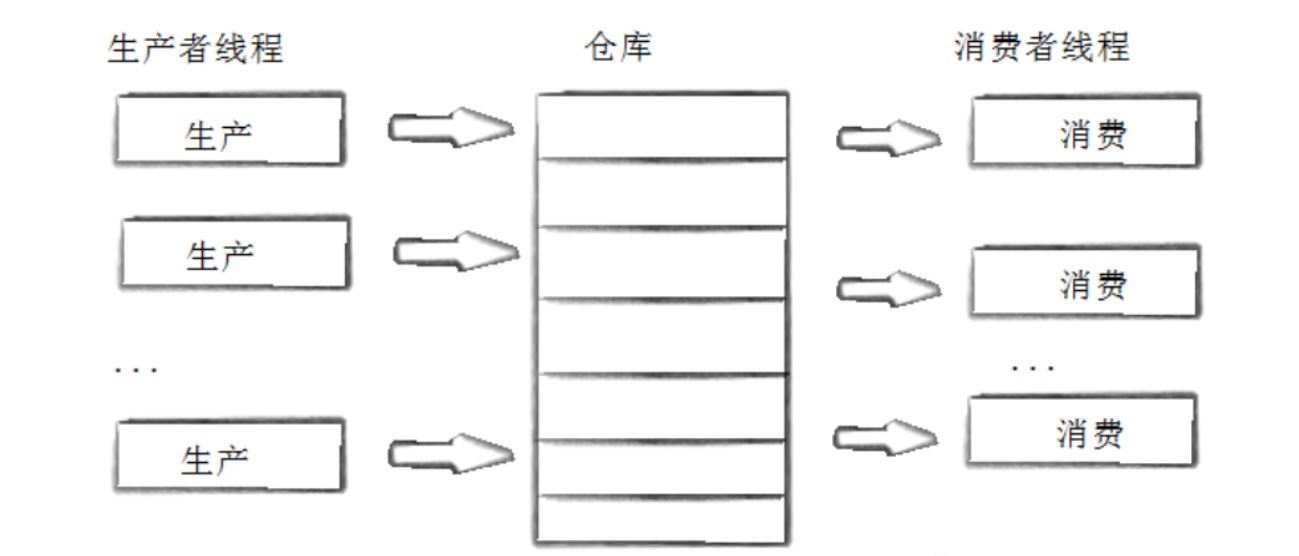6. 生产消费者模式 Producer-Consumer模式
6.1 概念
生产者消费者模式就是通过一个容器来解决生产者和消费者的强耦合问题。生产者和消费者彼此之间不直接通讯,而通过阻塞队列来进行通讯,所以生产者生产完数据之后不用等待消费者处理,直接扔给阻塞队列,消费者不找生产者要数据,而是直接从阻塞队列里取,阻塞队列就相当于一个缓冲区,平衡了生产者和消费者的处理能力。这个阻塞队列就是用来给生产者和消费者解耦的。

由于多个线程都访问了同一个阻塞队列,所以会有并发问题
- 生产者 vs 生产者:互斥
- 消费者 vs 消费者:互斥
- 生产者 vs 消费者:互斥,为了防止饥饿问题,也需要同步
所以这里有3种关系,2个角色(生产者和消费者),1个交易场所(特定结构的内存空间)
该模型的优点
- 解耦
- 支持并发
- 支持忙闲不均
注意,生产者生产的数据也是要花时间获取的,当有数据时,消费者做数据的加工处理,也是要花时间的
所以,不要只看到生产者生产数据到队列的过程,当阻塞队列队列满时,生产者在等待队列下等待过程中,是可以做获取数据的工作的。
同理,不要只看到消费者从队列中消费数据的过程,当阻塞队列为空时,消费者在等待队列下等待过程中,是可以做数据的加工处理动作的。
这样,这两个或者多个线程就并发高效的处理数据了,在多生产和多消费体现明显,少量的线程在等待,大量的线程在获取数据和加工数据。
6.2 基于 BlockingQueue 的生产者-消费者模式
这里是单生产者单消费者
// BlockQueue.hpp
#pragma once
#include <iostream>
#include <unistd.h>
#include <pthread.h>
#include <queue>
using namespace std;template<class T>
class BlockQueue
{static const int NUM = 10;
public:BlockQueue(int num = NUM) : _max(num){pthread_mutex_init(&_mutex, nullptr);pthread_cond_init(&_pCond, nullptr);pthread_cond_init(&_cCond, nullptr);}const T pop(){pthread_mutex_lock(&_mutex);// 判断临界资源是否满足也是在访问临界资源,所以要在加锁之后if(_q.size() == 0) {// 队列中没有值,不需要再删除了,让它去等待队列中去等pthread_cond_wait(&_cCond, &_mutex); // 调用的时候会自动释放锁,因唤醒而返回时,又会重新持有锁}const T x = _q.front();_q.pop();pthread_cond_signal(&_pCond); // 消费者已经消费数据了,此时就可以唤醒生产者了。pthread_mutex_unlock(&_mutex);return x;}void push(const T& x){ pthread_mutex_lock(&_mutex);if(_q.size() == _max) {// 已经到了最大值,不需要再添加了,让它去等待队列中去等pthread_cond_wait(&_pCond, &_mutex);}_q.push(x);pthread_cond_signal(&_cCond); // 生产者已经生产数据了,此时就可以唤醒消费者了。pthread_mutex_unlock(&_mutex); }~BlockQueue(){pthread_mutex_destroy(&_mutex);pthread_cond_destroy(&_pCond);pthread_cond_destroy(&_cCond);}private:queue<T> _q;pthread_mutex_t _mutex;pthread_cond_t _cCond; // 消费者条件变量pthread_cond_t _pCond; // 生产者条件变量size_t _max; // 队列能放的最大值
};
// main.cc
#include "BlockQueue.hpp"void* Consumer(void* args)
{BlockQueue<int>* bq = static_cast<BlockQueue<int>*>(args);while(true) {int data = bq->pop();printf("消费者消费了一个数据:%d\n", data);sleep(2);}}void* Producer(void* args)
{BlockQueue<int>* bq = static_cast<BlockQueue<int>*>(args);int data = 0;while(true) {data++;bq->push(data);printf("生产者生产了一个数据:%d\n", data);}
}int main()
{BlockQueue<int>* bq = new BlockQueue<int>();pthread_t c, p;pthread_create(&c, nullptr, Consumer, bq);pthread_create(&p, nullptr, Producer, bq);pthread_join(c, nullptr);pthread_join(p, nullptr);delete bq;return 0;
}
因为消费者消费的比较慢,所以消费者消费一个,生产者就生产一个

6.3 生产和消费Task
阻塞队列中存储的不仅仅可以是int,可以是自定义类型
// Task.hpp
#include <iostream>
#include <string>
using namespace std;enum TaskStatus
{DIV_ZERO=1,MOD_ZERO,UNKOWN
};char opStr[4] = {'+','-','*','/'};class Task
{
public:Task(int a, int b, char op) : _a(a), _b(b), _op(op) {}void Run(){switch (_op){case '+':_result = _a + _b;break;case '-':_result = _a - _b;break;case '*':_result = _a * _b;break;case '/':if (_b == 0) _exitCode = DIV_ZERO;else _result = _a / _b;break;case '%':if (_b == 0) _exitCode = MOD_ZERO;else _result = _a % _b;break;default:_exitCode = UNKOWN;break;}}string GetResult(){string resultStr;resultStr += to_string(_a);resultStr += _op;resultStr += to_string(_b);resultStr += '=';resultStr += to_string(_result);resultStr += " ";if (_exitCode != 0){resultStr += "error";resultStr += " ";switch (_exitCode){case DIV_ZERO:resultStr += "div zero";break;case MOD_ZERO:resultStr += "mod zero";break;case UNKOWN:resultStr += "unkown";break;}}elseresultStr += "ok";return resultStr;}string GetTask(){string resultStr;resultStr += to_string(_a);resultStr += _op;resultStr += to_string(_b);resultStr += '=';resultStr += "???";return resultStr;}private:int _a = 0;int _b = 0;char _op = ' ';int _exitCode = 0;int _result = 0;
};
// main.cc
#include "BlockQueue.hpp"
#include "Task.hpp"void* Consumer(void* args)
{BlockQueue<Task>* bq = static_cast<BlockQueue<Task>*>(args);while(true) {Task t = bq->pop();t.Run();printf("消费者获得数据: %s, 运算结果是: %s\n", t.GetTask().c_str(), t.GetResult().c_str());// sleep(1);}}void* Producer(void* args)
{BlockQueue<Task>* bq = static_cast<BlockQueue<Task>*>(args);int x = 0, y = 0;char op = ' ';while(true) {x = rand() % 100; // [0, 99]y = rand() % 100; // [0, 99]op = opStr[rand() % 4];Task t(x, y, op);usleep(10); // 模拟获取数据需要时间bq->push(t);printf("生产者生产了一个任务:%s\n", t.GetTask().c_str());// sleep(1);}
}int main()
{srand((unsigned int)time(nullptr));BlockQueue<Task>* bq = new BlockQueue<Task>();pthread_t c, p;pthread_create(&p, nullptr, Producer, bq);pthread_create(&c, nullptr, Consumer, bq);pthread_join(c, nullptr);pthread_join(p, nullptr);delete bq;return 0;
}

6.4 误唤醒
假设现在有一个消费者,多个生产者在它的条件变量下正在进行等待,现在消费者刚刚消费一个数据,阻塞队列于是就恰好有一个空位置,于是该消费者就去唤醒生产者,但是使用的不是pthread_cond_signal(&_pCond);而是pthread_cond_broadcast(&_pCond);
void push(const T& x)
{ pthread_mutex_lock(&_mutex);if(_q.size() == _max) {// 已经到了最大值,不需要再添加了,让它去等待队列中去等pthread_cond_wait(&_pCond, &_mutex);}_q.push(x);pthread_cond_signal(&_cCond); // 生产者已经生产数据了,此时就可以唤醒消费者了。pthread_mutex_unlock(&_mutex);
}
于是,这几个被唤醒的生产者就不在条件变量下等待了,而是都跑过去去竞争锁,但只有一个能竞争成功,该生产者于是就继续向下执行,向阻塞队列中push()数据。当该生产者生产完数据,准备唤醒消费者并解锁的时候,消费者不一定竞争成功锁,因为还有那些同样在刚才竞争锁资源失败的生产者在锁资源下等着呢!如果这些生产者又拿到锁,像阻塞队列中push()数据,就会发生错误,因为阻塞队列已经到_max了!
一个线程在条件满足被唤醒的时候,但是历史上的条件满足已经其它线程处理掉了,于是该线程只能等待,当它再次被唤醒,进行数据访问,就可能出错,我们把这种现象称为该线程被误唤醒了。或者叫虚假唤醒。即本不应该被唤醒线程被唤醒了,导致程序执行结果错误。
为了防止线程被虚假唤醒,判断临界资源是否可以被消费或生产的时候要用while()循环,循环判断,当条件不满足的时候,让该线程重新去等待队列中等待,而不是一股脑的一直在竞争锁资源
const T pop()
{// ...while(_q.size() == 0) {}// ...
}
void push(const T& x)
{// ...while(_q.size() == _max) {}// ...
}
6.5 多生产者多消费者
static const size_t C_NUM = 5;
static const size_t P_NUM = 5;
// ...
int main()
{srand((unsigned int)time(nullptr));BlockQueue<Task>* bq = new BlockQueue<Task>();pthread_t c[C_NUM], p[P_NUM];for(size_t i = 0; i < P_NUM;++i)pthread_create(c+i, nullptr, Producer, bq);for(size_t i = 0; i < C_NUM;++i)pthread_create(p+i, nullptr, Consumer, bq);for(size_t i = 0; i < P_NUM;++i)pthread_join(c[i], nullptr);for(size_t i = 0; i < C_NUM;++i)pthread_join(p[i], nullptr);delete bq;return 0;
}

由于BlockQueue中用了一把锁,所以生产者和生产者的互斥关系,生产者和消费者的互斥关系,消费者和消费者的互斥问题,都可以解决
生产和消费者的同步问题,我们使用了两个条件变量来解决
即便是多生产者多消费者,任何时刻,只允许一个线程来访问临界资源,让它来进行生产或消费





